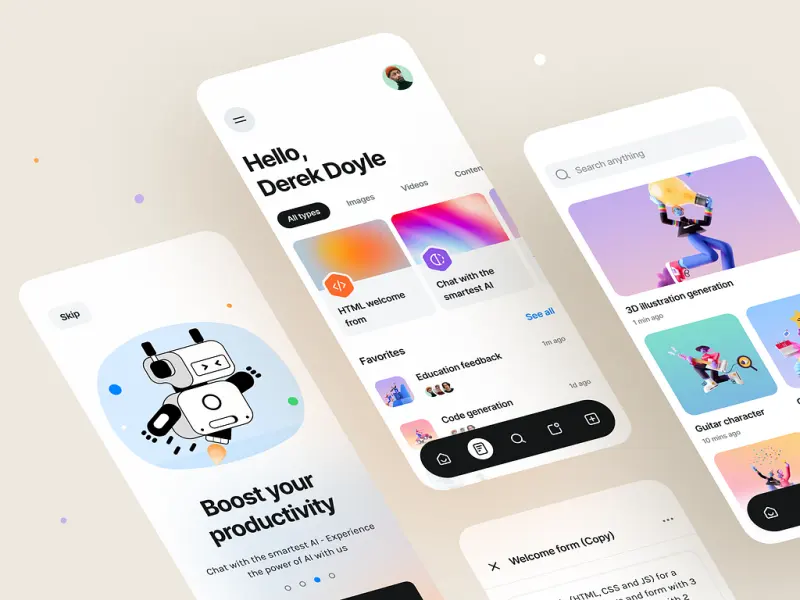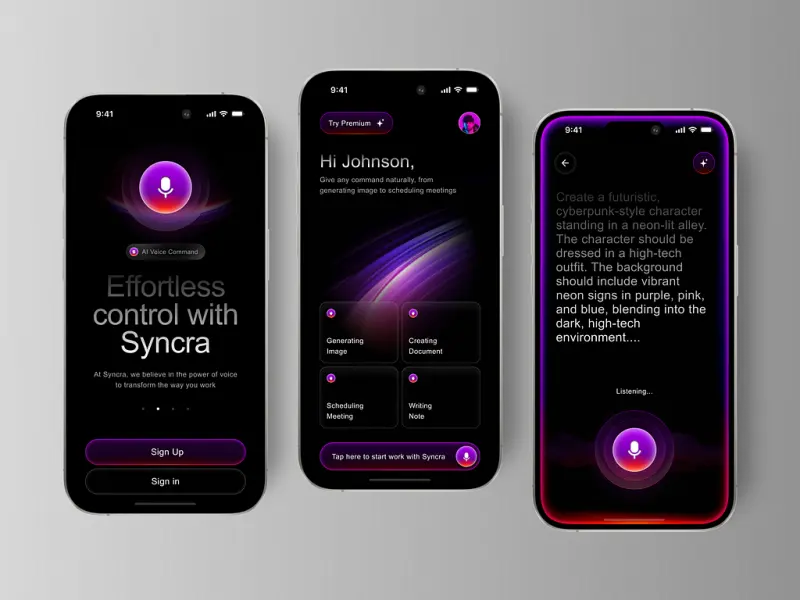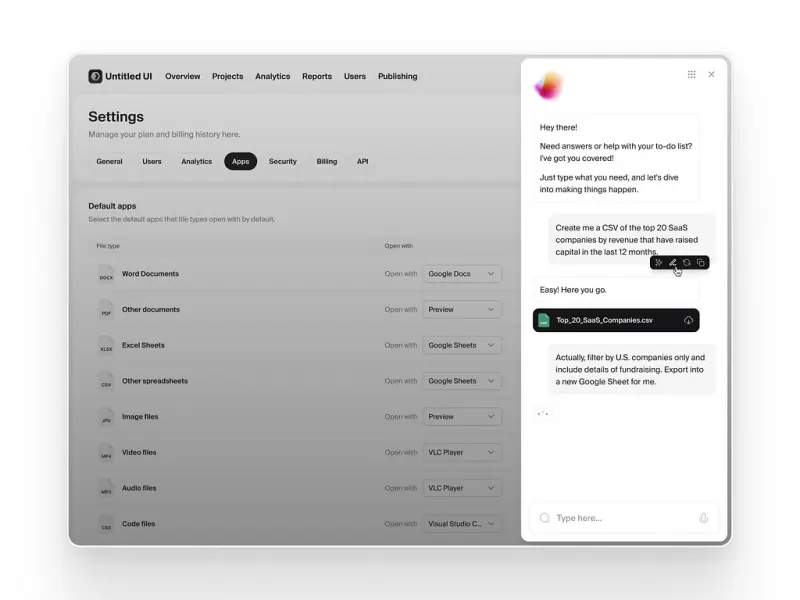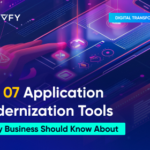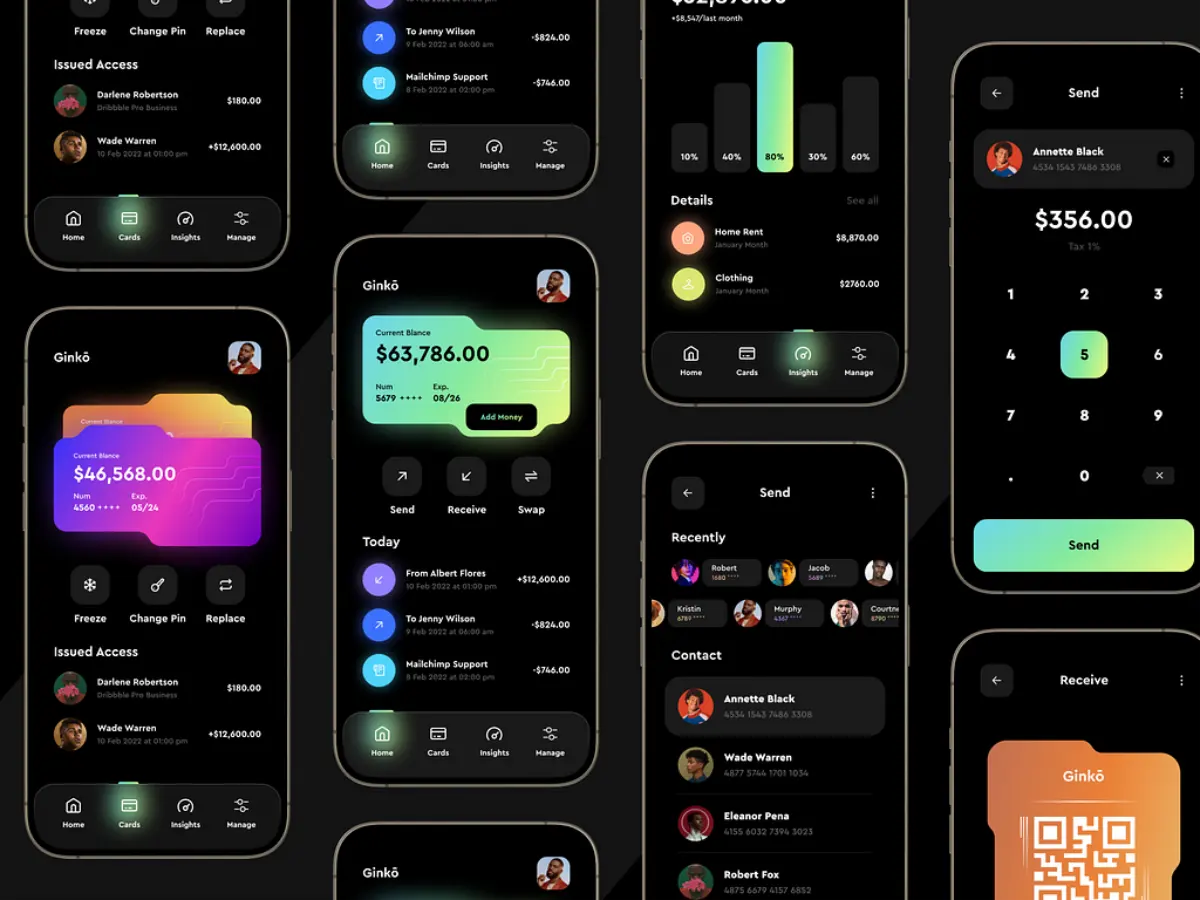How to Build an AI Agent: A Step-by-Step Guide for Business Owners
- TECHVIFY Team
- 0 Comments
AI has quickly become a game changer across many industries, especially in business, ever since OpenAI’s ChatGPT hit the scene. What started with simple question-and-answer bots is now evolving into AI agents capable of handling tasks with the same efficiency as humans.
In fact, around 64% of businesses expect AI to increase productivity, and 25% are turning to AI because they’re short on human resources. AI agents have come a long way from virtual assistants like Siri and Alexa. They’re now being used for things like drug discovery in healthcare, detecting fraud in finance, and optimizing supply chains in e-commerce.
So, if you want to stay ahead of the competition, connect with customers, and ultimately boost profits, it’s time to integrate AI into your business. But the big question is: How do you build an AI agent?
This guide will walk you through everything you need to know how to build an AI agent, whether you’re a developer or just an enthusiast.
I. Breaking Down The Definition of AI Agents
An AI agent is essentially a computer program designed to help people get things done and answer their questions. The focus here is on helping people.
AI Agent Example
AI agents can assist with day-to-day tasks like managing emails, scheduling appointments, and even providing updates on the weather or the latest news. These agents are built to understand and respond to human language, making interactions feel more natural and easy to navigate.
There are different types of AI agents, such as assistive agents and autonomous agents. Assistive agents, for example, can be embedded in employee tools to help with personalized tasks specific to their role. On the other hand, autonomous agents can handle customer questions and requests without any human involvement. These agents are built using tools like Agentforce, which allows them to operate dynamically, responding to changes in data and automation, rather than following a strict set of rules.
Training an AI agent involves several important steps to make sure it performs well and meets your needs. These steps include collecting and preparing data, training the model, evaluating its performance, fine-tuning it, and finally deploying it. Once it’s up and running, you’ll also need to regularly monitor and update your AI agent to ensure it continues to align with your business goals. Let’s break down these steps so you can get started on building your own AI agent.
Learn More On:
II. 5 Main Types of AI Agents
There are various types of AI agents, each suited to different industries and applications depending on the complexity of tasks required. Below are the main types of AI agents you can choose from:
- Simple Reflex Agents
Simple reflex agents are the most basic form of AI agents. They operate by reacting to their environment based on a set of predefined rules. These agents don’t consider the broader context or history of events—they simply respond to specific stimuli. For example, a basic thermostat that turns on the heat when the temperature drops below a certain threshold is a simple reflex agent. - Model-Based Reflex Agents
Model-based reflex agents offer more complexity than simple reflex agents. Instead of merely reacting to triggers, they build an internal model of their environment. This allows them to make more informed decisions by referring to this internal model before taking action. For instance, a robot navigating a room might build a map of the space to avoid obstacles more effectively. - Goal-Based Agents
Goal-based agents are designed with specific objectives in mind. These agents don’t just react—they actively work towards achieving their predefined goals. They can plan their actions and evaluate different strategies to meet their objectives. For example, a self-driving car needs to navigate roads safely and effectively. It constantly makes decisions to ensure it reaches its destination, considering factors such as traffic and road conditions. - Utility-Based Agents
Utility-based agents take goal-based reasoning a step further by evaluating different options based on a predefined measure of “goodness” or utility. These agents strive to maximize utility, which is a measure of how favorable an outcome is. For example, a recommendation system might consider factors like user preferences, product ratings, and popularity to suggest the most useful or desirable items. - Learning Agents
Learning agents get better over time by picking up on things from past experiences. These agents adapt based on feedback from their environment or user interactions. For instance, an AI-based spam filter is a learning agent—it gets better at identifying spam emails as it processes more examples, continuously refining its understanding of what constitutes spam.
III. The Elements of Building and Training AI Agents
Building and training an AI agent means teaching it how to understand and respond to human language in ways that are helpful and relevant. Whether you’re working with generative AI (GenAI) or conversational AI, the key to success lies in your data. Training an AI agent brings together several important concepts from the fields of artificial intelligence, especially machine learning and natural language processing (NLP). Let’s break down each of these.
Machine Learning
Machine learning (ML) is a form of AI that gives computers the ability to automatically learn and improve from experience—without needing to be explicitly programmed. When training an AI agent, machine learning algorithms analyze historical data (like examples of human interactions) to identify patterns and make decisions. The more data the AI agent processes, the better it becomes at predicting and responding to user requests.
The basics of building AI agent
Natural Language Processing
Natural language processing (NLP) is a part of AI that’s all about how computers and people communicate using everyday language. The goal is for computers to be able to process and understand large amounts of language data. In the case of AI agents, NLP allows the system to grasp, interpret, and generate human language in a way that feels natural and meaningful.
Data Labeling
Data labeling is a crucial part of training AI. It involves humans adding meaningful tags or labels to raw data so the AI can learn from it. For example, when training an AI agent, data labeling might include marking parts of speech in sentences, identifying the sentiment of a text, or categorizing queries by topic. This labeled data helps the AI understand the context and intent behind user inputs, guiding it to make more accurate responses.
Have a Project Idea in Mind?
Get in touch with experts for a free consultation. We’ll help you decide on next steps, explain how the development process is organized, and provide you with a free project estimate.
IV. How to Build An AI Agent: The 6 Essential Steps
So, you’ve decided to implement an AI agent—great choice! Now, it’s all about turning that idea into a real, functioning product tailored to your business needs. At TECHVIFY, we follow a six-step process to build AI agents that deliver results.
Step 1: Define the Purpose and Role of Your AI Agent
The first step in building an AI agent is to clearly define what you want it to do. This means identifying the specific tasks and functions the agent will perform. Here’s how to approach this:
Start by listing the problems you want the AI agent to solve or the tasks you want it to handle. Do you need an autonomous agent that can interact with customers without human intervention? Or perhaps you require a shopping assistant that helps users navigate your online store, offering recommendations based on their preferences and past behavior?
Next, consider who your target audience is. Different users will have different expectations when interacting with AI. For example, an AI agent designed for healthcare professionals will need to understand medical terminology, while one for eCommerce customers should be able to recommend products and compare prices.
Finally, define the situations or use cases where your AI agent will be deployed. Understanding these will help clarify the features and capabilities your agent needs. For instance, a customer service chatbot must handle inquiries and complaints, while a virtual shopping assistant should focus on product suggestions and user preferences.
Step 2: Gather and Prepare Your Training Data
Just like humans learn from studying textbooks, AI agents learn from data. The quality of your data is crucial—poor data leads to poor performance. Ensuring that your AI has clean, high-quality data to train on will make all the difference.
First, collect data that reflects the kind of interactions your AI agent will have. This can include:
- Text transcripts: Gather conversation logs, support tickets, or emails that resemble what users might ask your AI.
- Voice recordings: For voice-based agents, collect recordings that reflect the various accents, intonations, and speech patterns your AI might encounter.
- Interaction logs: Previous interactions with similar systems can provide valuable insights into common user behaviors and queries.
Once you have your data, you’ll need to clean it. This means removing irrelevant information, fixing errors, and ensuring consistency. Finally, you’ll want to label the data—adding tags that describe what each piece of data means. For example, you might label a text as “asking for store hours” or “requesting a refund.” These labels help the AI understand the context and intent behind user inputs.
Step 3: Select the Right Machine Learning Model
Choosing the right machine learning model is crucial because it determines how well your AI agent will learn from data and perform its tasks.
There are two main types of machine learning models to choose from:
- Neural networks: These models are inspired by the human brain and are excellent at processing large amounts of data, making them ideal for understanding and generating human language.
- Reinforcement learning: This model learns through trial and error, improving over time based on feedback from its actions. It’s particularly useful for agents that need to make decisions or optimize their behavior based on user interactions.
How do you decide which model to use? It depends on the tasks your AI agent will perform and the type of data you’ve collected. For example, if your AI needs to generate human-like responses, a neural network might be the best option.
You can also use pre-trained models as a starting point. These models have already been trained on large datasets and can be fine-tuned for your specific application. Some popular pre-trained models include:
- GPT (Generative Pre-trained Transformer): Great for generating text and answering questions.
- BERT (Bidirectional Encoder Representations from Transformers): Useful for understanding context in language, such as for sentiment analysis or language translation.
Fine-tuning a pre-trained model involves further training it with your specific dataset, allowing it to adapt to the needs of your business.
How to build an AI agent
Step 4: Train Your AI Agent
Now it’s time to train your AI agent using the data you’ve prepared. This is where your AI starts learning from the examples you provide, so it can eventually carry out its tasks independently.
Here’s how to train your AI agent:
- Set up your environment: Start by setting up the machine learning environment with the necessary software libraries and frameworks.
- Load your data: Bring in the cleaned-up, labeled data to your system.
- Split the data: Divide your dataset into a training set (to teach the model) and a testing set (to evaluate its performance).
- Choose a model: Select and initialize the machine learning model that best fits your AI agent’s tasks.
- Configure training parameters: Set the parameters that guide the training process, such as learning rate, batch size, and number of epochs.
- Train the model: Begin the training process. The model will adjust its internal settings to minimize errors and improve over time.
- Monitor performance: Keep an eye on key metrics like accuracy and loss. If the model isn’t learning as expected, you may need to adjust the training parameters.
Step 5: Test and Validate Your AI Agent
Before deploying your AI agent, you need to ensure it performs well in real-world scenarios. Testing and validation help you catch any issues early on and fine-tune the agent’s performance.
Start by running your AI agent through tasks similar to those it will handle once deployed. This is like giving it a practice test to see how well it’s learned.
You should also measure how accurately and efficiently your AI responds. Does it provide the right answers? Does it respond quickly enough? Are the interactions smooth?
Here are some testing methods you can use:
- Unit testing: Evaluate individual components of your AI to ensure they work correctly.
- User testing: Have real users interact with the AI in a controlled environment to see how it performs in real-world conditions.
- A/B testing: Test different versions of your AI agent to determine which one performs better in specific situations.
Make sure to watch out for overfitting, which happens when an AI performs well on training data but struggles with new, unseen data. You can address this by using techniques like cross-validation.
Step 6: Deploy and Monitor Your AI Agent
Once your AI agent has passed testing, it’s time to deploy it in a live environment.
Start by deciding where you want the AI agent to operate—whether it’s on your website, within a mobile app, or on a voice-activated platform. Then, integrate it into the chosen platform by embedding the necessary code or configuring APIs.
After launch, closely monitor how the AI agent interacts with users. Does it understand queries correctly? Is it handling conversations smoothly? Use real-time monitoring tools to track performance metrics like response times, accuracy, and user satisfaction.
Collect feedback from users to continuously improve the AI agent. You can also set up error logging to catch any issues that arise and address them promptly. By regularly monitoring and updating your AI agent, you can ensure it adapts to user needs and continues to perform at its best.
Want to see more AI article? Check here:
V. Why Building Your Own AI Agent is a Smart Move
AI agents are not here to replace humans entirely, but they can absolutely take on basic tasks with greater speed and accuracy. So, how does building your own AI agent benefit your business? After looking at various case studies, the advantages are clear. Here are the top reasons why AI agents can be a game-changer for your team, customers, and overall profitability.
1. Improving Efficiency Across the Board
Many businesses deal with repetitive tasks like data entry, invoice processing, and document management. Instead of allowing employees to focus on higher-value work, these tasks can eat up a lot of time. AI agents excel at handling such repetitive tasks, freeing up your team for more strategic activities.
An AI agent can also tap into multiple data sources within your company. For example, in a retail business, this might include sales data and customer relationship information. Unlike humans, AI agents can efficiently process this data and use it to make well-informed decisions.
2. Cutting Down on Operational Costs
Automating routine tasks with AI can help reduce operational expenses. Beyond that, AI agents can open up other cost-saving opportunities depending on how you use them. Here are some examples:
- Predictive maintenance: By installing sensors on your equipment, AI agents can track data trends and predict when components might need replacing, helping you avoid expensive repairs.
- Fraud detection: In the finance industry, AI can analyze transaction data to spot unusual patterns that might indicate fraud.
- Inventory management: In eCommerce, AI agents can monitor stock levels to prevent shortages and help manage logistical costs more efficiently.
AI agents can carry out these tasks at scale—something that would require a lot of manpower if done manually.
3. Making Smarter, Data-Driven Decisions
AI agents are great at transforming raw data into valuable insights by uncovering hidden patterns and trends. This helps businesses make smarter decisions based on data. These AI-driven assistants provide real-time recommendations, adjust to changing business environments, and optimize processes to keep your business running smoothly.
VI. AI Agents: 5 Key Use Cases
You already know how AI agents can benefit your business but seeing how other companies leverage them can be a great source of inspiration. Many businesses use generative AI services to build custom AI agents that suit their specific needs. Let’s explore five key areas where AI agents are being used effectively to drive results.
Build AI agents
1. E-Commerce AI Consultant
In the e-commerce space, AI agents track trends such as emerging product categories and seasonal demand fluctuations. These AI-powered consultants can also recommend product assortments, pricing strategies, and inventory levels by analyzing sales data and customer feedback.
Advantages:
- It improves the customer experience by giving personalized product suggestions.
- Automates repetitive tasks like inventory management and order processing.
- Provides data-driven insights on product selection, pricing, marketing strategies, and customer segmentation.
Applicable industries:
- E-commerce, logistics, wholesale, and distribution.
Real-world examples:
While there’s no standalone AI product that fits this use case exactly, Amazon’s machine learning algorithms provide a great example. Amazon’s recommendation engine analyzes customer purchase history, browsing behavior, and product reviews to suggest relevant products, increasing sales and customer satisfaction. Additionally, it uses AI to predict product demand, optimize inventory levels, and prevent stockouts or overstocking.
2. Customer Service Agents
Many businesses implement AI agents to handle customer service tasks such as answering frequently asked questions, resolving basic issues, and guiding users through complex processes.
Benefits:
- Offers round-the-clock availability, quick response times, and personalized interactions that boost the overall customer experience.
- Automates routine queries, allowing businesses to manage customer requests at scale.
- Analyzes customer interactions to uncover trends, preferences, and problem areas, leading to improved service delivery.
Industries suited for:
- Banking, healthcare, travel, and retail.
Examples in practice:
Capital One’s Eno is a great example of AI in banking, assisting customers with account balances, transfers, and transaction history. Additionally, Amazon Alexa, while primarily a smart home device, also helps customers track orders, manage returns, and get product information, making it a versatile AI customer service agent.
3. LLM-Based AI Agents
LLM-based (Large Language Model) AI agents go beyond simple text generation. Like digital assistants, these agents can understand complex queries, execute tasks, and learn from experiences. However, they use advanced cognitive capabilities to handle more intricate tasks, such as interactive dialogue, problem-solving, and providing personalized assistance.
Key advantages:
- Capable of addressing complex problems and offering suitable solutions based on context and user needs.
- Useful for driving research, innovation, and development, such as in drug discovery or new product creation.
- Delivers personalized, empathetic interactions in customer service, leading to higher satisfaction rates.
Industries where it applies:
- Healthcare, finance, education, and marketing.
Notable examples:
AI-powered chatbots often rely on LLMs for their capabilities. A notable example is GitHub Copilot, which suggests code completions and generates code snippets for developers, making it a valuable tool for software engineering teams.
4. AI Voice Agents
AI voice agents can interpret and respond to human speech, offering businesses a more natural and efficient communication channel. These agents are often used to enhance customer experience, whether for handling customer queries, driving sales, or other voice-based applications.
What it offers:
- Provides consistent, professional voice interactions, improving company credibility and trust.
- Cost-effective for managing high call volumes and handling repetitive tasks.
- Can be utilized for content creation, such as audio ads, product demos, and training materials.
Relevant sectors:
- Hospitality, marketing, customer service, education, and entertainment.
Examples:
Popular AI voice agents include Google’s Gemini, Apple’s Siri, and Amazon Alexa. Many businesses also use AI-powered interactive voice response (IVR) systems to route calls, provide information, and handle basic customer inquiries more efficiently.
5. Roles-Based AI Agents
A roles-based AI agent is a specialized AI program designed to perform specific tasks or functions within a defined context. These agents are assigning a specific job—such as customer support representative, personal financial advisor, or marketing strategist—to the AI.
Advantages it brings:
- Equipped with specialized knowledge and understanding related to its assigned role or industry.
- Focuses on fulfilling the responsibilities tied to its designated function, ensuring task-specific performance.
Industries that benefit:
- Roles-based AI agents are versatile and can be implemented in virtually any industry.
Practical examples:
ClickUp AI is an excellent example of a roles-based AI agent. It offers various roles, such as writer, editor, or project manager, each designed to perform specific tasks like writing task descriptions, creating meeting agendas, or summarizing project progress.
Conclusion
AI agents are revolutionizing how businesses operate, from enhancing customer service to streamlining processes and enabling data-driven decisions. Regardless of your industry, integrating AI can help automate tasks, deliver personalized experiences, and boost overall efficiency, providing a competitive edge in today’s digital landscape.
However, building and deploying AI agents tailored to your unique needs requires the right expertise. That’s where TECHVIFY comes in. Our team can guide you through every step of the process, from identifying the best AI solutions for your business to ensuring seamless integration and long-term success.
Ready to explore how AI can transform your business? Contact TECHVIFY for a free consultation and let’s discuss how we can help you unlock the full potential of AI technology.
TECHVIFY – Global AI & Software Solution Company
From Startups to Industry Leaders: TECHVIFY prioritizes results, not just deliverables. Accelerate your time to market and see ROI early with high-performing teams, AI (including GenAI) Software Solutions, and ODC (Offshore Development Center) services.
- Email: [email protected]
- Phone: (+84)24.77762.666




